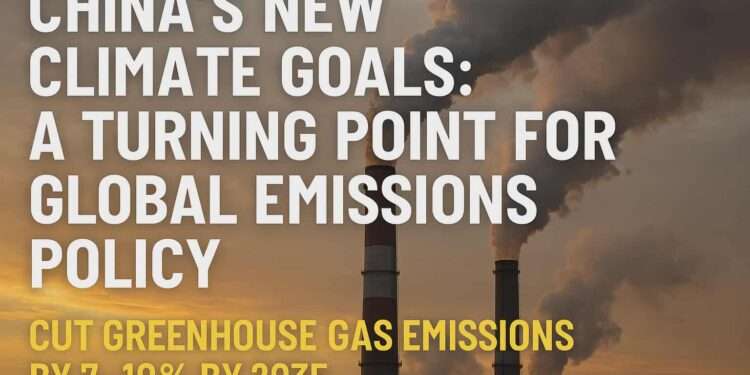China’s New Climate Goals: A Turning Point for Global Emissions Policy
Introduction
China launched an innovative climate program on September 25, 2025 which introduced new approaches to worldwide environmental emission management and sustainable practice development. President Xi Jinping announced at the United Nations Climate Summit that China plans to reduce greenhouse gas emissions between 7–10% by 2035 as part of its extended economic strategy that connects sustainable development to the national economic framework.
The announcement emerges at a vital time because China stands as the world’s biggest polluter which makes its decisions vital for both local and global climate initiatives. For policymakers, scientists, and investors, this represents more than a pledge — it’s an early glimpse into how the balance of global power and responsibility might shift over the next decade.
Why This Target Matters
China currently accounts for nearly 30% of global carbon emissions. While the nation has made progress in renewable energy development — becoming the world leader in solar panel production and wind energy installation — critics often note that coal remains a dominant energy source.
For more context, see this BBC News analysis covering the latest developments.
China demonstrates its dedication to worldwide scientific standards through its objective to decrease emissions by 7–10%. The Paris Agreement temperature targets of 1.5–2°C require substantial emission cuts according to climate experts.
The new goal stands as a superior achievement to previous symbolic statements because it includes specific timeframes and measurable objectives and demands international involvement which boosts its global recognition.
The Global Context
China’s announcement doesn’t exist in isolation.
The United States continues to follow its climate agenda through the Biden administration which supports renewable energy growth and enhanced emission regulations.
…as detailed in our report on the 2025 South China Sea vessels collision.The European Union has created a Green Deal roadmap to reach climate neutrality across all European territory by 2050.
The countries of Africa and South Asia along with other developing nations seek financial backing and technological assistance to reach their sustainability targets.
China takes the lead in worldwide climate talks because it sets specific measurable targets for environmental protection. The new global power dynamics would create a major shift in the Asia-Pacific region.
Economic Implications
China views climate policy as an economic approach instead of an environmental issue.
1. Renewable Energy Growth
China leads the world in solar panel and wind turbine manufacturing as well as electric vehicle production. The domestic sector needs to grow stronger because this expansion will generate employment opportunities for millions of people while boosting export capabilities.
2. Coal Dependency Challenge
Roughly 60% of China’s electricity still comes from coal. The government needs to solve this problem by implementing efficient methods to manage industrial requirements against environmental responsibilities for economic growth.
3. Green Technology Leadership
China can establish global energy market leadership through its investments in green hydrogen and battery storage and carbon capture technologies.
Environmental Impact
China’s successful implementation of emissions reduction measures would block billions of tons of carbon dioxide from reaching the atmosphere during the period up to 2035. The implementation of this policy would lead to quantifiable changes in Asian global temperature increase and Asian sea-level patterns and Asian air quality.
The health outcomes within China would experience substantial improvement as a result. Research indicates that air pollution results in the deaths of millions of people before their time each year. The healthcare system would experience lower pressure while urban residents would enjoy improved quality of life as coal and fossil fuel consumption decreases.
Challenges Ahead
The execution of this process faces various obstacles which stop it from reaching its full potential.
China has not received independent verification for the implementation and transparency of its previous climate commitments. The global community requires assessment of the new plan to determine its effectiveness in tracking.
…as explored in our article on Trump, NATO & Russia’s oil pre-sanctions.China maintains its position as the world’s second-largest economy through its heavy industrial sector which drives its ongoing growth. The execution of environmentally friendly solutions requires strategic management to stop economic decline.
The United States and Europe and neighboring countries maintain political tensions which might hinder international climate cooperation even when China implements successful domestic climate policies.
How the World Reacts
The international community reacted to China’s announcement with diverse opinions which mostly expressed support.
Climate advocates identified this step as vital because any progress toward the targets would produce major advantages.
The 7–10% reduction target receives criticism because it seems too low to handle the current scale of emissions. They call for deeper reductions to align with the UN’s 2030 climate urgency timeline.
The financial industry received the news positively because it would advance renewable energy development and green financial initiatives.
SEO-Optimized Takeaways
China has established a new emissions target which includes reducing greenhouse gas emissions between 7% to 10% below current levels by 2035.
Global climate leadership: The move positions China as a major force in international sustainability negotiations.
The economy will experience a fast growth in renewable energy systems and electric vehicles and green technology sectors.
The environment benefits from cleaner air and reduced global warming risks which produce improved public health outcomes.
The organization faces three main obstacles which prevent it from maintaining transparency in coal use and achieving sustainable development goals.
Conclusion
China’s implementation of particular emission reduction targets demonstrates a policy shift which goes beyond traditional environmental control measures. The statement serves as a declaration of purpose which addresses both domestic residents and international market rivals and environmental concerns. China faces actual obstacles but the potential benefits from this move exceed them because it will transform its national economy and create a lasting impact on worldwide climate change efforts.
China’s climate strategy has moved past domestic issues because it now shapes Earth’s environmental future for 2035 according to global recognition.

